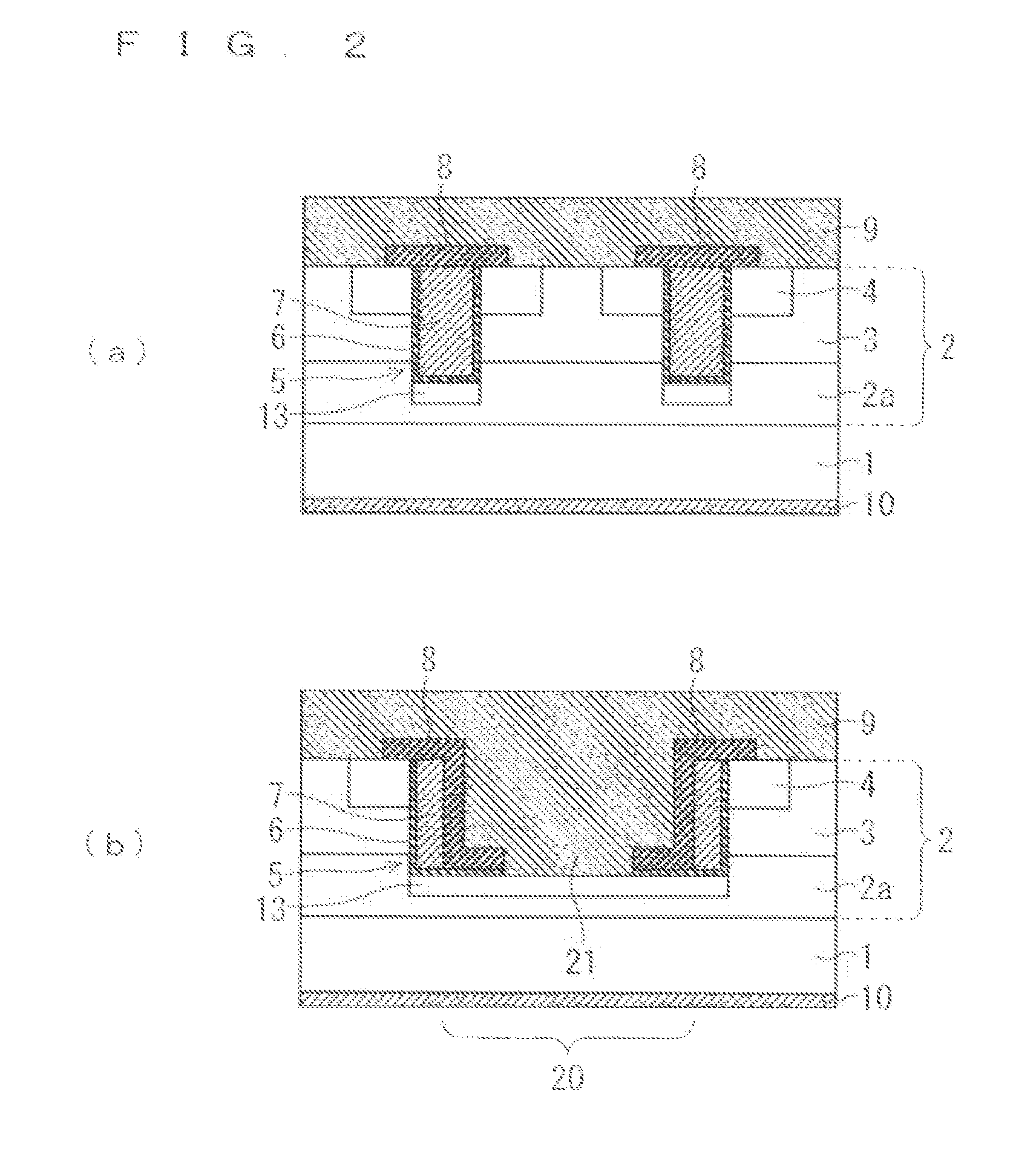Semiconductor device and manufacturing method therefor
a semiconductor and semiconductor technology, applied in the direction of semiconductor devices, electrical devices, transistors, etc., can solve the problems of dielectric and achieve the effects of preventing the breakdown of the gate insulating film caused by displacement current, reducing the resistance of the protective contact, and small resistance value between the protective diffusion layer and the base region
- Summary
- Abstract
- Description
- Claims
- Application Information
AI Technical Summary
Benefits of technology
Problems solved by technology
Method used
Image
Examples
first embodiment
[0033]FIG. 1 and FIG. 2 are views each illustrating a configuration of a semiconductor device according to a first preferred embodiment. Here, a trench-gate type MOSFET is illustrated that is a silicon carbide (SiC) semiconductor device as one example of the semiconductor device. FIG. 1 is a plan view of the MOSFET. FIG. 2(a) is a sectional view taken along line A-A of FIG. 1, and illustrates a MOSFET cell forming region (MOSFET cell region). On the other hand, FIG. 2(b) is a sectional view taken along line B-B of FIG. 1, and includes a contact (protective contact) forming region 20 (protective contact region) to be connected to the protective diffusion layer. Details of the protective contact region 20 will be described later.
[0034]The MOSFET in the first preferred embodiment is formed by using an epitaxial substrate composed of an n-type SiC substrate 1 and an epitaxial layer 2 (semiconductor layer) of n-type SiC grown thereon. A p-type base region 3 is formed in the upper part of...
second embodiment
[0067]As described in the first preferred embodiment, the gate electrode 7 can be formed by any one of the patterning and etchback methods. However, when the trench 5 of the protective contact region 20 is formed into a tapered shape and the gate electrode 7 is tried to be formed by etchback, the gate electrode 7 disposed in the trench 5 of the protective contact region 20 might be completely removed.
[0068]The above problem is solved by forming the gate electrode 7 through the patterning. However, in this case, since the end of the gate electrode 7 is positioned on the upper surface of the epitaxial layer 2, the width of the gate electrode 7 becomes wider than the width of the trench 5. Therefore, from a viewpoint of narrowing of the pitch of the MOSFET cells, it is advantageous to obtain the gate electrode 7 through etchback.
[0069]In the second preferred embodiment, therefore, only the gate electrode 7 disposed in the trench 5 of the protective contact region 20 is formed by patter...
third embodiment
[0074]FIG. 13 is a sectional view illustrating the configuration of the semiconductor device according to the third preferred embodiment of the present invention, and illustrates a cross section of an outermost peripheral portion of a MOSFET cell array of the semiconductor device. In this preferred embodiment, a dummy cell 30 that does not function as a MOSFET is disposed so as to be adjacent on an outer side of the outermost peripheral MOSFET cells. The dummy cells 30 are arranged so as to surround the MOSFET cell array. A configuration of the MOSFET cell array (including the protective contact region 20) other than the outermost peripheral portion is similar to that in the first or second preferred embodiment.
[0075]As shown in FIG. 13, the dummy cell 30 has the trench 5 that penetrates the base region 3 similarly to the MOSFET cells, but the inside of the trench 5 is filled with a part of a field insulating film 22 to be formed on an outer peripheral region of the semiconductor de...
PUM
 Login to View More
Login to View More Abstract
Description
Claims
Application Information
 Login to View More
Login to View More - R&D
- Intellectual Property
- Life Sciences
- Materials
- Tech Scout
- Unparalleled Data Quality
- Higher Quality Content
- 60% Fewer Hallucinations
Browse by: Latest US Patents, China's latest patents, Technical Efficacy Thesaurus, Application Domain, Technology Topic, Popular Technical Reports.
© 2025 PatSnap. All rights reserved.Legal|Privacy policy|Modern Slavery Act Transparency Statement|Sitemap|About US| Contact US: help@patsnap.com



